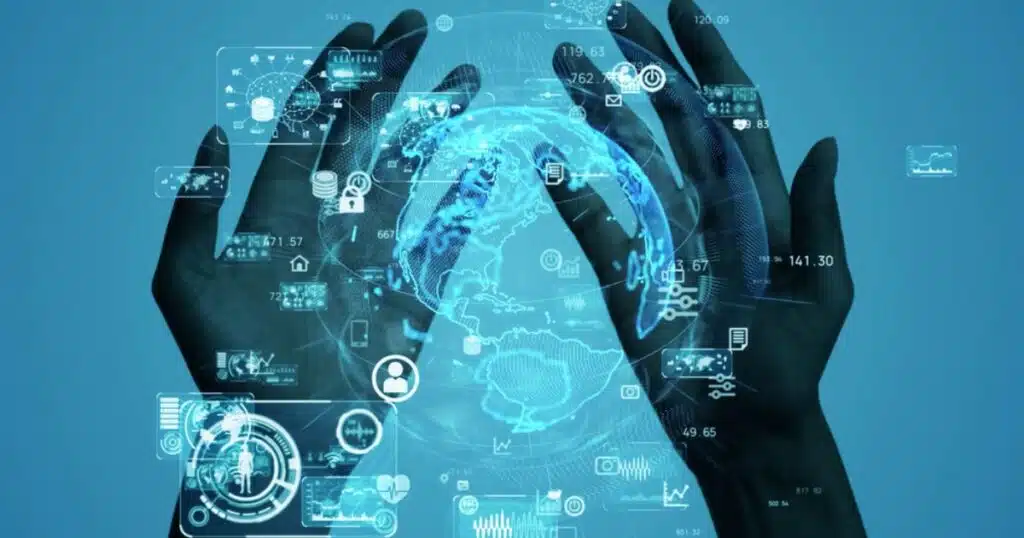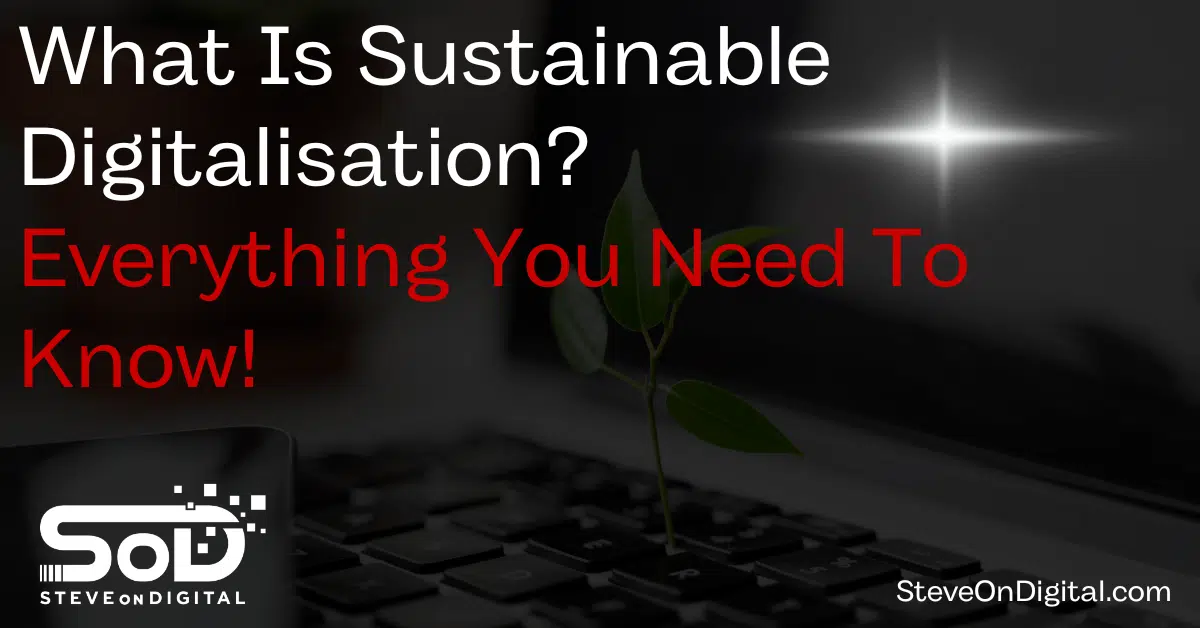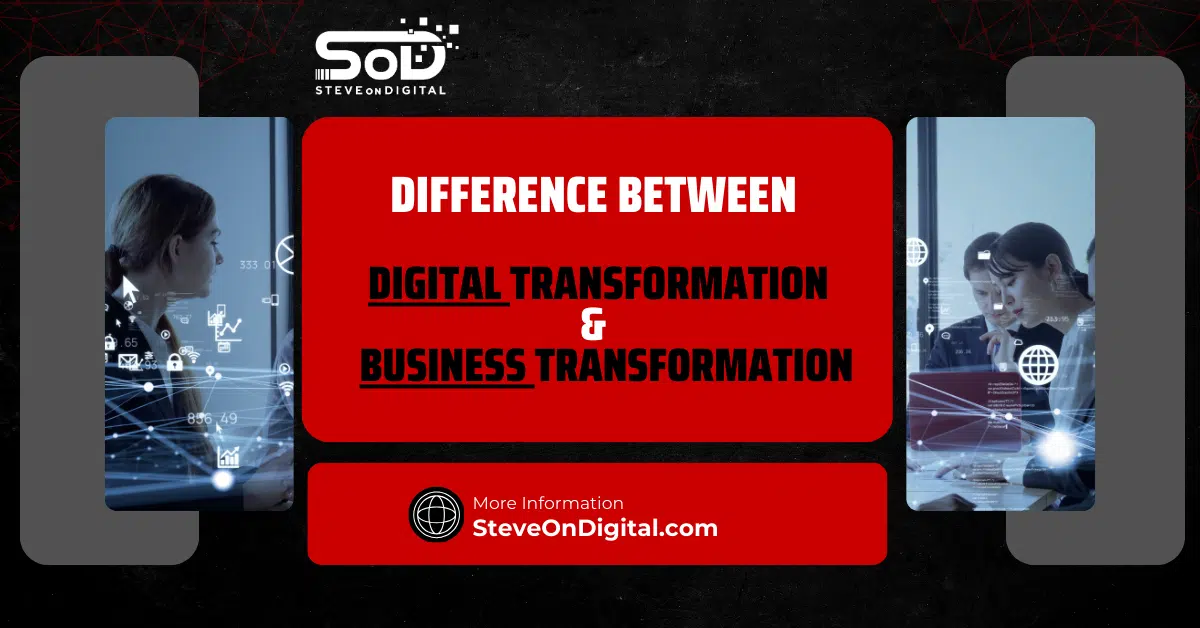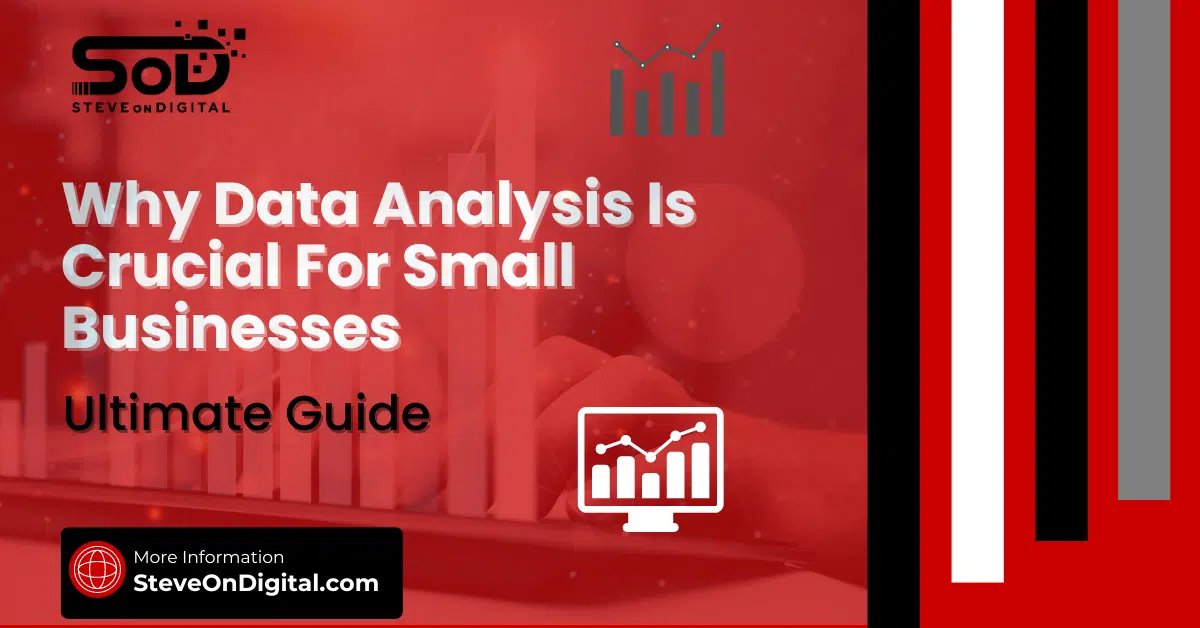Hi, I’m Steve Johnston, your guide through the transformative world of sustainable digitalisation.
What does this mean? Simply put, sustainable digitalisation is the integration of digital technology into sustainability efforts.
This combination aims to achieve environmental, social, and economic benefits simultaneously.
As a digital transformation specialist with a background in electrical engineering and extensive experience in project management, I’ve witnessed first-hand how technology can spearhead monumental changes, not just in businesses but in the very fabric of society.
Today, let’s set the stage for understanding why this integration is crucial in our current technological landscape.
Exploring the Fundamentals
Defining The Concept And Core Principles
Sustainable digitalisation isn’t just a buzzword; it’s a pivotal strategy in facing today’s environmental and technological challenges.
It involves what I like to call the twin transition—marrying digital and environmental transformations to forge a path that’s not only innovative but also conscious of our planet’s health.
The core principles of sustainable digitalisation include:
- Energy Efficiency: Utilizing technologies that minimize energy consumption and reduce the carbon footprint of digital operations.
- Sustainable Digital Transformation: Leveraging digital tools and solutions to promote sustainable practices across various sectors.
- Long-term Benefits: Focusing on sustainable development that safeguards the interests of future generations.
- Technology Development: Emphasizing the importance of ethical standards and practices in technology development, including promoting ethics and responsibility in digital technology and respecting human rights and privacy in data handling.
In my journey with small and medium-sized businesses (SMEs), I’ve employed digital solutions that not only boost efficiency but also reinforce sustainability.
It’s not just about being better; it’s about being responsible and foresighted.
Digital Technologies Driving Sustainability
The role of digital technologies in driving sustainability is more significant than ever.
Here are a few ways how:
- Artificial Intelligence (AI): AI is a powerhouse in optimizing energy use in everything from data centers to smart grids, dramatically lowering energy consumption and improving energy efficiency. As someone who’s delved into the practical applications of AI in business, I’ve seen its impact in streamlining operations and reducing waste.
- Internet of Things (IoT): IoT devices collect and analyze data in real-time, allowing for more precise control of energy use and resource management. This technology helps businesses understand their impact and make proactive changes towards sustainability.
- Blockchain: Known for its robust security features, blockchain can also enhance transparency in sustainable practices, ensuring that companies are accountable for their environmental goals.
As we continue to advance in the digital age, it’s crucial to harness these technologies not just for economic growth but for a sustainable future.
In my role, I’ve guided many SMEs to integrate these digital tools effectively, ensuring they contribute positively to global sustainability efforts.
Benefits Of Sustainable Digitalisation
Environmental Impact
As we continue our exploration of sustainable digitalisation, it’s vital to understand its profound environmental benefits.

Digital solutions like smart grids and precision agriculture are pivotal in transforming how we use our natural resources, ultimately supporting our environmental goals.
As someone deeply embedded in the digital transformation landscape, I’ve seen these technologies first-hand:
- Smart Grids: These systems optimize electricity distribution and improve fault detection, significantly reducing energy consumption. In my projects with SMEs, implementing smart grids has not only cut costs but also lessened their environmental impact.
- Precision Agriculture: This technology uses digital tools to guide farming practices, which can minimize waste and increase efficiency. By applying data-driven decision making, farmers can use fewer pesticides and fertilizers, protect the environment, and increase crop yields.
Such technologies not only help in reducing resource consumption but also contribute to a sustainable future by lessening the ecological footprint of digital activities.
Social And Economic Advantages
The impact of sustainable digitalisation extends beyond environmental benefits; it also encompasses significant social and economic advantages.
Here’s how digital tools are revolutionizing access to essential services and fostering economic growth:
- Education: Digital platforms can reach underserved communities, offering remote learning opportunities and digital skills training. This democratization of education is crucial for societal progress and is a cornerstone of sustainable development.
- Healthcare: Telemedicine and digital health records improve access to care and patient outcomes, especially in remote areas. These innovations are part of sustainable practices that enhance human health and societal well-being.
- Economic Growth: Digital technologies drive the digital economy, creating jobs and opening new markets. My experience with local economic development has shown that digital transformation can spur significant economic growth, providing sustainable business practices that are both profitable and environmentally sound.
Addressing Challenges In Sustainable Digitalisation
Bridging The Digital Divide
One of the critical challenges in sustainable digitalisation is ensuring that it is inclusive.
The digital divide—the gap between those who have access to digital technologies and those who do not—remains a significant barrier.
Here are a few ways we can bridge this divide:
- Infrastructure Development: Building more robust digital infrastructure in underserved areas is essential. This includes not just physical infrastructure but also access to affordable internet services.
- Education and Training: Providing digital skills training can empower people across all levels of society to participate in the digital age.
As a member of an incubator board, I advocate for these initiatives, emphasizing that digital access is a right, not a privilege.
Managing Energy And Resource Demands
The increase in digital activities brings its own set of challenges, notably in managing the energy and resources they demand.
Here are some strategies to balance these demands with energy-efficient solutions:
- Green Data Centers: Utilizing renewable energy sources and improving server efficiency can drastically reduce the energy consumption of data centers.
- Eco-friendly Design: Encouraging companies to design products and infrastructure that are easy to recycle and have a smaller environmental footprint is another step toward sustainable digitalisation.
Through concerted action and commitment to these strategies, we can manage the ecological impacts of our digital transformation.
It’s not just about adopting new technologies but doing so in a way that respects and preserves our natural environment for future generations.
Case Studies And Real-World Applications
Success Stories In Sustainable Digital Transformation
As we dive deeper into the impact of sustainable digitalisation, it’s inspiring to look at real-world success stories.
These case studies not only showcase the potential of digital technologies but also demonstrate the tangible benefits of sustainable digital transformation.
- Smart City Initiatives: Cities around the world are utilizing digital tools to improve everything from traffic management to energy use. For instance, in Copenhagen, smart traffic lights reduce congestion and lower emissions, a prime example of how technology can facilitate a sustainable future.
- Renewable Energy Integration: The use of digital technology to better manage renewable energy sources is revolutionary. Companies like Enel Green Power are employing advanced analytics and AI to optimize the performance of their renewable assets, significantly boosting energy efficiency and reducing carbon footprint.
These initiatives highlight not just innovation but also a commitment to environmental goals and sustainable practices that benefit society as a whole.
Corporate Initiatives Towards Digital Sustainability
Leading companies worldwide are not just adopting digital solutions; they are integrating sustainable practices into their digital strategies.
This approach reflects a robust commitment to corporate responsibility and sustainable development.
- Google’s Sustainable Servers: Google has been a front-runner in reducing the energy consumption of data centers, which are notoriously energy-intensive. Their commitment to achieving 24/7 carbon-free energy by 2030 showcases how big tech can lead in sustainable digitalisation.
- IKEA’s Smart Home Products: IKEA is another example of a company that integrates sustainability into its digital offerings. Their smart home products are designed to help consumers reduce energy use, aligning with broader environmental goals.
These examples underscore how companies can assume social responsibility and leverage digital innovation to promote sustainability and economic growth.
Future Directions For Sustainable Digitalisation
Innovations Shaping Sustainable Digital Futures
Looking forward, the evolution of digital tools and technologies is poised to dramatically shape sustainable practices.

Here are a few innovations that are on the horizon:
- Advanced AI for Efficiency: Artificial intelligence is becoming increasingly sophisticated, with new algorithms capable of predicting and mitigating energy use across various industries, thus enhancing energy efficiency.
- Blockchain for Transparency: Blockchain technology is proving to be crucial in increasing transparency in supply chains, helping companies track and prove their sustainable practices and reducing resource consumption.
These technological advancements are paving the way for a more sustainable and efficient future, proving that the digital revolution is integral to global sustainability.
The Twin Transition: Climate And Digital Transformation
The concept of the twin transition refers to the dual focus on addressing both the climate crisis and digital transformation.
This transition represents both a challenge and an opportunity:
- Challenge: Balancing the rapid pace of digital innovation with the need to reduce its environmental impact is a complex task. However, it’s crucial for ensuring that our advancements in digital technology do not come at an unsustainable cost.
- Opportunity: The digital revolution provides unique tools and platforms to tackle climate change more effectively. From modeling climate patterns to optimizing resource use, digital technologies can play a pivotal role in crafting solutions that are both innovative and sustainable.
In my role as a digital transformation specialist, I’ve seen how embracing this twin transition can drive not just technological advancements but also significant environmental and social improvements.
It’s about ensuring that our journey towards a digital age also steers us towards a sustainable future, leveraging digital solutions to build a world that’s better for all.
Empowering Through Knowledge And Skills
Enhancing Digital Skills For A Sustainable Future
In the journey toward sustainable digitalisation, one of the most crucial steps is enhancing digital skills across all levels of society.
This commitment to education and training ensures that everyone, from young students to seasoned professionals, can participate effectively in the digital economy.
Here’s why building these skills is essential:
- Workforce Readiness: As digital technologies evolve, the demand for skilled professionals follows. By providing training in AI, blockchain, and other digital tools, we prepare individuals to lead and innovate within the technology sector.
- Lifelong Learning: In my own career, continual learning has been key. From early beginnings in electrical engineering to later gaining an MBA and a master’s in project management, each step was crucial in understanding how digital transformation can drive sustainable practices.
| Skill Area | Description | Importance in Sustainability |
| Data Analysis | Ability to interpret and derive meaningful insights from data. | Crucial for optimizing resource use and improving sustainability metrics. |
| Artificial Intelligence | Knowledge of AI applications to automate and optimize processes, reducing energy consumption. | Enhances efficiency and decision-making in sustainable practices. |
| Cybersecurity | Skills to protect and secure data, ensuring privacy and integrity in digital operations. | Essential for safe digital transformations and maintaining trust. |
| Blockchain Technology | Understanding blockchain for transparency and secure data transactions. | Supports sustainability in supply chains and enhances accountability. |
Empowering people with the right skills leads to more innovative and effective solutions in sustainable digital transformation, fostering a workforce that is not only tech-savvy but also environmentally conscious.
Data-Driven Decision Making For Sustainability
Data is at the heart of modern digitalisation efforts.
Leveraging data for actionable insights is crucial in driving sustainability.
Here’s how:
- Resource Management: Through data analytics, companies can minimize waste and improve efficiency, crucial for reducing resource consumption and enhancing sustainable development.
- Environmental Impact Analysis: Data helps track and analyze the environmental impact of digital infrastructures, aiding in the continuous improvement of sustainable practices.
| Aspect | Traditional Practices | Sustainable Practices |
| Energy Source | Mostly non-renewable (coal, oil) | Renewable (solar, wind) |
| Resource Efficiency | Often overlooked in favor of cost or speed | Prioritized; includes recycling and sustainable sourcing |
| Product Lifecycle | Designed for obsolescence | Designed for longevity, reparability, and recycling |
| Data Handling | Basic security and compliance | Advanced cybersecurity measures and ethical data use |
In my work, employing data-driven strategies has provided SMEs with the tools to make informed decisions that align with their environmental goals while still promoting growth and innovation.
Overcoming Barriers And Ensuring Progress
Tackling Cybersecurity And Privacy Concerns
With the increase in digital activities, cybersecurity and privacy concerns are more prominent than ever.

Here’s how we can address these issues:
- Enhanced Security Protocols: Implementing robust security measures to protect data integrity and privacy is essential. This includes encryption, two-factor authentication, and continuous security training for all digital users.
- Regulatory Compliance: Staying updated with the latest regulations and ensuring compliance is crucial for maintaining trust and accountability in digital operations.
Addressing these concerns is not just about safeguarding information but also about building a digital society that values and protects its members’ privacy and security.
Metrics And Accountability In Sustainable Digitalisation
To truly measure the effectiveness of sustainable digitalisation efforts, clear metrics and standards are necessary:
- Sustainability Reporting: Companies should regularly report their sustainability metrics, including energy consumption, carbon footprint, and other relevant environmental impacts.
- Stakeholder Engagement: Involving all stakeholders in the reporting and decision-making process ensures transparency and accountability, reinforcing the commitment to sustainable practices.
| Metric | Description | Why It Matters |
| Carbon Footprint | Total amount of greenhouse gases produced, directly and indirectly, by activities or products. | Key indicator of environmental impact, helps in setting reduction targets. |
| Energy Efficiency | Energy usage efficiency in processes and systems. | Directly correlates to reducing operational costs and environmental impact. |
| Resource Consumption | Amount of natural resources used in production and operation. | Essential for monitoring and improving sustainable resource use. |
| Waste Reduction | Reduction in waste production through better practices and recycling. | Reduces environmental pollution and promotes circular economy practices. |
By establishing and adhering to these metrics, businesses and organizations can not only track their progress but also demonstrate their commitment to a sustainable future.
Final Thoughts
Reflecting on the journey of sustainable digitalisation, it’s clear that this is not just a technological shift but a transformative movement towards a more responsible and efficient world.
The potential of digitalisation to drive sustainability is immense, but it requires concerted action and collaboration across various sectors.
As we continue to innovate and transform, let us remember the ultimate goal: to create a world where technology and sustainability go hand in hand, benefiting not just current but also future generations.
Together, we can build a digital age that is truly sustainable and inclusive.




